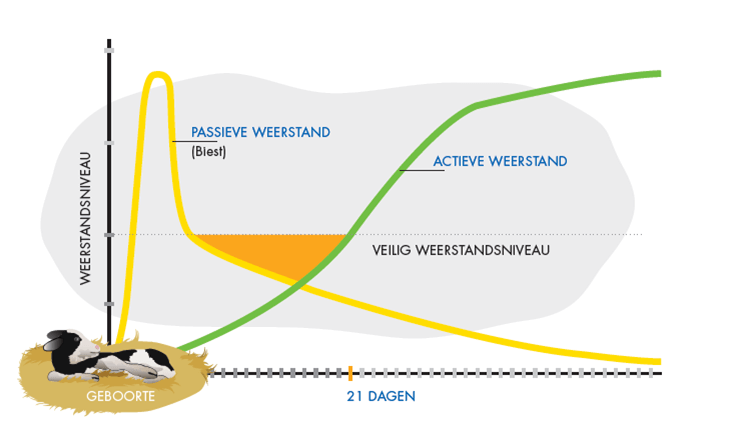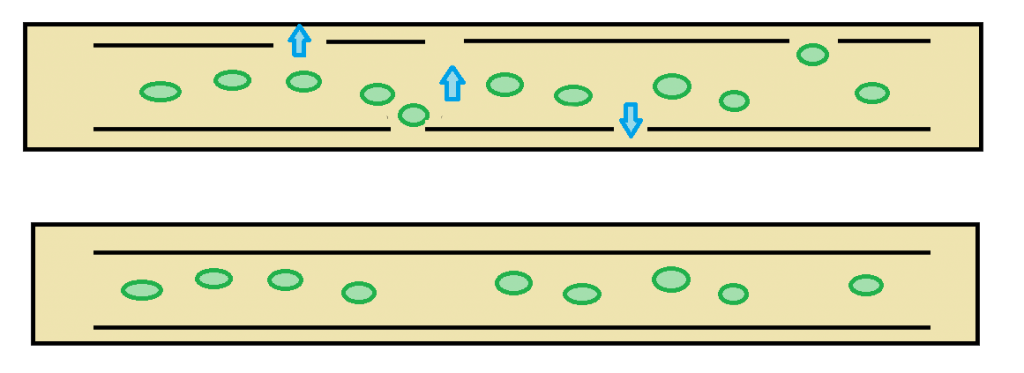Colostrum management, important?
Yes! Colostrum management is an essential factor for a good start of calf rearing. Timing, amount, and quality may have a huge impact on the development of the immune system in calves.
Immunity
Calves are born without any protection against pathogens. The first line of defence (antibodies) is provided from the colostrum, also called passive immunity. The calf is not yet able to produce its own antibodies. For a proper uptake of antibodies from colostrum, it is crucial that the calf starts drinking colostrum as soon as possible after birth (at least 2 litres).

Abeelding 1: Passieve immuniteit verkregen uit de biest, neemt langzaam af. Actieve immuniteit (het eigen afweersysteem) moet zich nog ontwikkelen bij het pasgeboren kalf. Afbeeldingsbron: Sprayfo (Trouw Nutrition)
Gut permeability
Immediately after birth, the uptake of antibodies is high, because the gut wall is permeable for large molecules at that time. This allows antibodies to pass the gut wall and enter the blood stream. Over time, the permeability of the gut wall diminishes; that is why it is so important to offer colostrum immediately after birth.
It is also useful to repeat the supply of colostrum after a few hours, because the uptake of antibodies occurs mainly in the first 12 hours after birth. Thereafter, the uptake of antibodies in the intestine declines, because the permeability of the gut wall diminishes.

Figure 2 of 3: Schematic overview of gut wall permeability. In the first hours after birth the gut wall is permeable for antibodies from colostrum (upper picture), thereafter, the gut wall closes (lower picture).
Application
Supplying colostrum not only provides vitamins, minerals, moisture and energy to the new-born calf, it also guarantees the necessary defence against pathogens. Good quality colostrum should be given at the right temperature. A combination of the optimal temperature (around 40 oC) and drinking position (with the calf’s head tilted upwards) ensures that the colostrum reaches the right stomach. Milk is digested in the abomasum, and the functional oesophagus slot reflex in young calves ensures that milk does not end up in the rumen.
Goals of colostrum management:
- Soon: as soon as possible after birth
- A lot: first colostrum feeding at least 2-3 L
- Often: at least three colostrum meals on the first day of life (6 L)
- Fresh ±40 °C: this temperature stimulates the oesophagus reflex
Hygiene
Left over colostrum? Keep it cool and hygienic for the next feeding, or keep frozen for later use.
Colostrum qualitiy
To obtain the best quality of colostrum, milk the cow completely immediately after parturition. At that time, the quality of the colostrum is the highest; thereafter, the colostrum is gradually diluted with ‘normal’ milk, and the quality declines.
The cow’s ration in the dry period also greatly affects the quality of the colostrum. An adequate minerals and trace elements supply in the dry period results in better colostrum quality.
To determine the actual colostrum quality, the use of a refractometer is recommended. This device measures the dry matter content of the first milk, and the amount of immunoglobulins associated with it. A Brix value of well over 21 represents a good colostrum quality. Below 21 characterizes moderate or bad quality.



